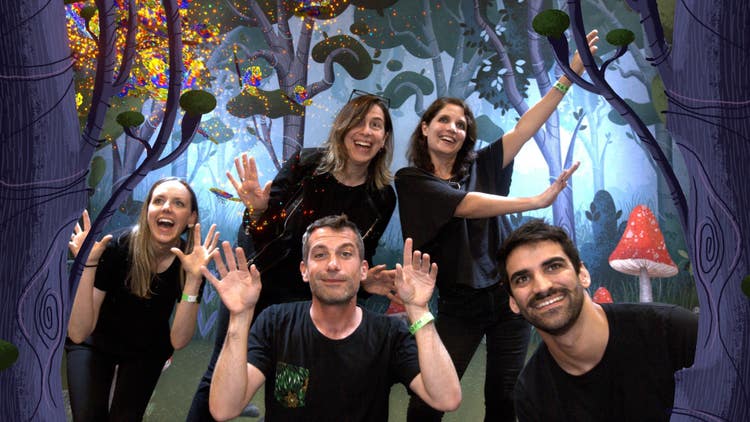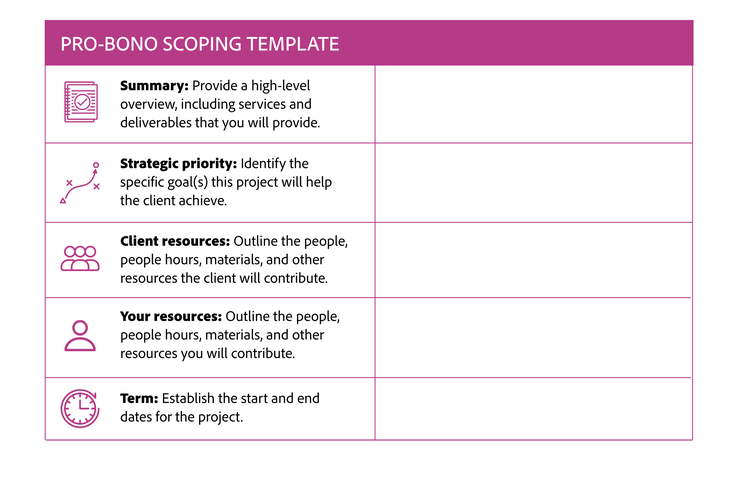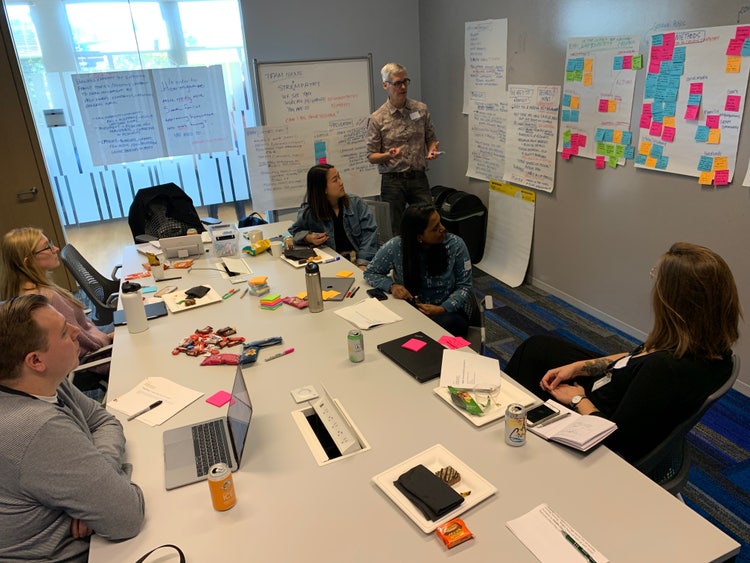A guide to launching a pro bono program for your design organization
How to scope, execute, and champion volunteer projects that make an impact

Illustration by Kenzo Hamazaki
Pro bono projects not only benefit communities and not-for-profit organizations, they also offer creative teams a chance to step outside of their day-to-day duties and stretch in new ways, as they take on expanded leadership roles or hone their partnership and advocacy skills.
A pro bono program can start small, but it’s especially impactful when it becomes a regular part of your design organization’s practice. Whether you’re a design leader, an operations team member, or an individual contributor with the drive to make a difference, here’s how to launch a pro bono program for your organization, with lessons learned from Adobe Design’s own projects and partnerships.
Step 1: Identify the skills your team can donate
The critical first step to launching a pro bono program is putting some real forethought into what your organization can give and what they want to achieve. Start by answering these questions:
What unique skills are present in your organization?
We leaned into the broad range of skills across our teams: In addition to designers and design leaders, our organization includes prototypers, content strategists, experience researchers, design strategists, and program and product managers. We’re able to tackle big projects from research to concept to prototype to execution, as we did in our partnership on SFMoMA’s Self Composed activation, by using the industrial design, experience design, engineering, and content strategy skills across our teams to bring the exhibit to life.
We’re also able to tap specific teams for more focused projects. Our extremely talented icons team led the design for The Lexicon’s Foodicons project, creating a new set of guidelines and icons for a universal, open-source visual language to help consumers understand where their food comes from and its environmental impact.
What kinds of volunteer activities motivate your team?
What excites your team, and who do they want to engage with? Think about what will compel them to want to raise their hands for volunteer opportunities, and what will fulfill them enough to keep them coming back for more.
We’ve found that our organization is especially motivated to volunteer for education and mentorship opportunities—from teaching design skills to evangelizing design careers—for students and people considering their professional options. Through partnerships with design-education focused not-for-profits, like Inneract Project (a Bay Area, California-based organization empowering the next generation of Black, Latinx, and underrepresented designers of color), and organizations that work directly with schools like Project Invent (whose mission is to empower students to succeed through design-thinking and invention), our team members can get a creative recharge doing what they love: Sharing career stories, facilitating workshops, and directly connecting with the next generation of designers.
What professional skills can someone demonstrate on a project that will help them to drive their career forward?
Pro bono programs aren’t entirely selfless endeavors. Consider how you can use these extra-curricular projects to help your team develop new skills or scratch an itch they can’t in their everyday work.
Our organization is often motivated to participate because of the ways they can expand their professional and creative skills in an impactful way. Many team members are interested in taking on more leadership responsibilities and find that volunteer initiatives are a great way to grow those skills. Some join not-for-profit boards, others raise a hand to be a project lead.
Step 2: Find the right not-for-profit partner
If your company has a Corporate Social Responsibility Team or leaders with established not-for-profit relationships, start by investigating whether there are any existing projects your organization can plug into. You can also research and reach out to not-for-profits that match up with the skills and motivations you explored in Step 1.

For not-for-profit organizations we partner with, I like to ensure the following criteria are met:
- Has the organization been established for at least four years? Non-profits lose their tax-exempt status if they fail to file taxes for three years in a row. This information also allows you to see where money is being spent and if there are discrepancies that could be red flags.
- Do they have a good reputation? Resources like Charity Navigator or Guidestar can help with researching their history.
- Does the organization have an EIN number? Are they a 501(c)3? This is especially helpful if your company has opportunities for grant matching.
- Does their mission align with your company values? Your team’s goals and focus areas?
- In initial conversations, do they treat your organization with respect? This is important: You want to be sure your team will have a positive experience partnering with the organization.
- Consider where your team is located. Are there opportunities for in-person, hybrid, and/or virtual engagements? What would be most impactful for your team and for the partner organization?
Step 3: Scope the project
Pro bono projects are many things—meaningful, fulfilling, constructive—but they’re also a commitment your team is making. Figure out what kind of time and resources you’re able to invest so each partnership is a success. This template can help create structure around your project, supply transparency for all parties, and protect against scope creep.

As with any project, you’ll want to set accurate expectations and protect your team’s time. Once you’ve found your project, you’ll want to understand due dates for any deliverables by working backward from important milestone and deliverable dates to create a schedule.
Examining the full project scope will help you decide if the project is possible given the time needed each week to complete, divided by the number of volunteer hours that your team can commit. With the full picture of the project in mind, you’ll also be able to pinpoint opportunities to help your team build on or prove their professional skills.
Step 4: Rally your resources
Leadership and management buy-in is critical for a pro bono program, especially when it takes time away from company projects. Have an open dialog with your organization or company leadership, and start small: Demonstrate the professional value of these partnerships by taking on a one-off project before you gradually grow your program.
Corporate sponsorship can be a powerful addition to your team’s volunteer hours. Explore whether there’s a sponsorship budget to help fund project expenses, or other ways to supplement your team’s time with funding. Adobe employees log their volunteer hours that generate monetary grants that can be donated back to the not-for-profit.


Volunteers are the key to any pro bono engagement. If you have a smaller team, you may already have an idea of who to tap for it. If you have a larger team (Adobe Design has over 600 team members worldwide), send an email or Slack message to gather volunteer interest. Volunteers should share their interest, communicate what they’d like to gain from the engagement, and get manager approval for participation.
Communicate your team’s volunteer accomplishments back to your organization, and when possible, the wider world. If you have an internal communications or PR team, reach out to them and explore ways to share this work: Your volunteers will feel recognized, the organization can benefit from the exposure, and it may motivate more volunteers for future projects.
Step 5: Measure success and show gratitude
Now that you have at least one pro bono project under your belts, look at whether it satisfied the needs of your partner and the skills your volunteers hoped to flex. We define different metrics of success for each project, typically including the impact of the work, the skills developed or demonstrated by our team, volunteer hours logged, funds raised, and sentiment about the engagement from our team and the not-for-profit.
Finally, celebrating each completed project or engagement is important for morale and ensuring repeat volunteers. Thank your team for their time and dedication, your company partners for their advocacy, and the not-for-profit for opening themselves up to the engagement. And thank yourself as well: It takes many people across a design organization to execute a successful pro bono program, but only one person to take the first step toward making it a reality.